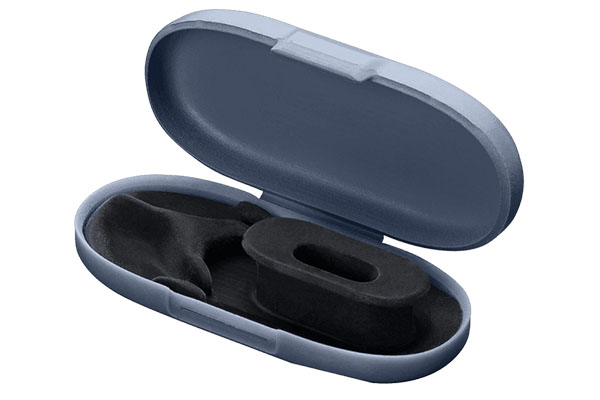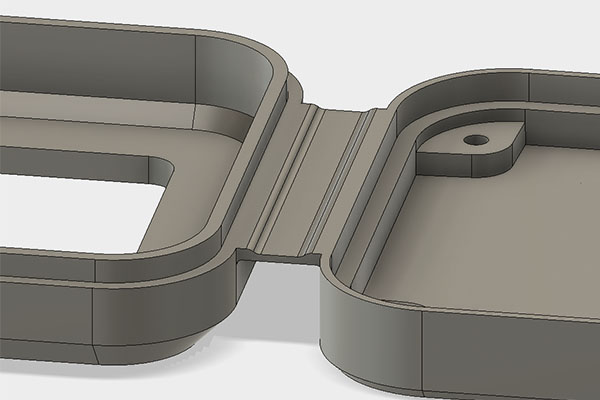Living Hinge: How to Design it for Custom Parts
At Sungplastic, we can design best living hinge for your needs. To help you get started with live hinge, we’ll go over several important design, manufacturing, and material issues in the discussion that follows.

Dimensions and Design
Since its introduction in the 1960s, the actual dimensions in living hinge design have changed very little. Living hinge typically features a slender, elongated shape, often measuring anywhere from a few millimeters to a few centimeters in width. Their length can vary considerably, depending on the specific application, ranging from a few centimeters to several inches. The thickness of a living hinge is usually a fraction of a millimeter, designed to maintain flexibility while still providing structural integrity.
Furthermore, the radius of curvature along the hinge’s length is another critical dimension to consider. This radius can vary widely, depending on the material, the intended flexibility, and the overall design requirements. Smaller radii result in tighter bends, while larger radii create gentler curves, impacting the hinge’s performance and longevity.
Despite these various dimensions and design options, living hinge has retained their core principles of being thin, flexible, and integrally made from the same material as the connected components. These enduring characteristics have made them a staple in various industries, especially in the realm of consumer electronics and packaging.

Best Practices of Living Hinge Design
Here are six essential best practices to consider when designing living hinge:
Incorporate Ample Radii
Ensure that your design includes generous radii. These rounded curves facilitate smooth material flow during the molding process and reduce stress concentrations when the hinge is in use.
Implement ‘Shoulders’
Integrate ‘shoulders’ within the part design to create a flat recess. This not only ensures that the hinge bends at the center but also allows the part to deform adequately, providing space for the hinge to close effectively.
Opt for Thin and Flexible
While a thicker hinge might seem sturdier, it can lead to greater surface elongation, potentially causing the material to surpass its yield point and shortening the hinge’s lifespan. Instead, opt for a thinner hinge, as it offers improved flexibility.
Divide Long Hinges
For hinges exceeding a length of six inches, consider designing them in two or more segments. This approach enhances the longevity and performance of the hinge.
Experiment with Thickness
The thickness of the hinge greatly influences its operational feel, determining whether it feels stiff or loose. You may need to experiment with various thicknesses to find the optimal fit for your specific design.
Pay Attention to Orientation
Be mindful of the orientation of plastic molecules, as it significantly affects joint strength and consequently hinge durability. Whenever possible, align the long plastic molecules perpendicular to the hinge. While viable hinges can be created with parallel orientation (such as in extrusion), this may not maximize the material’s strength.
While it’s beneficial to use the typical polypropylene design as a starting point, remember to tailor these foundational principles to meet the specific requirements of your product design.
Production Methods
Living hinge can be fabricated within final production parts using two primary methods: injection molding and extrusion, with injection molding being the more robust approach. For prototyping purposes, 3D printing and urethane casting are excellent alternatives. Let’s delve into each of these production methods and discuss the best material options and essential design considerations unique to each method.
For swift prototyping, including the option of receiving 3D-printed parts within 24 hours, simply upload your files below to obtain instant quotes for 3D printing and urethane casting.
Living Hinge Design for Injection Molding
Injection molding stands as the most robust technique for constructing living hinge, particularly for mass production.
Best Material Option
Polypropylene, renowned for its toughness and ductility, reigns supreme as the ideal material choice for injection-molded living hinge. A well-designed, injection-molded polypropylene hinge can exhibit an almost infinite service life, enduring several million flexes. Polyethylene serves as the second most common material for living hinge, possessing properties akin to polypropylene.
Design Tips
In injection molding, maintaining uniform wall thickness is a fundamental design rule. However, when designing a living hinge, you must diverge from this norm by creating non-uniform walls. To ensure flexibility, the hinge should be much thinner than the connecting rigid part.
Potential issues can be mitigated or eliminated by thoughtfully considering the placement of the mold gates. A comprehensive guide for optimal gate placement can be found in the MIT Guide to Designing Living Hinges.
It’s worth noting that immediately after molding, the hinge should be flexed several times. This process cold-draws the plastic, significantly enhancing its service life. A useful tip for simplifying tooling modification is to begin with the flat section above the hinge having a depth of at least 0.015 inches and a hinge thickness of 0.006 inches.
Living Hinge Design for Urethane Casting
Urethane casting offers a valuable option for bridging the gap between prototyping and production.
Best Material Option
Urethane resins encompass a wide family of materials with diverse properties. Many manufacturers around the world stock resins similar to polypropylene, the preferred material for living hinges. Within this family, a tradeoff exists concerning the durometer of the material. You can opt for rigid parts with a short-lived hinge or a flexible hinge with soft part walls. Some recommended materials include the Hapflex™ 600 series and BCCplastics BC8160 resin, specially formulated for living hinge applications. Your manufacturer may possess other suitable resins and can assist you in selecting one tailored to your design.
Design Tips
During polyurethane casting, flow pressures are considerably lower than in injection molding. Therefore, a compromise is necessary. Reduced pressures mean less resin flow, necessitating a thicker hinge compared to injection molding for reliable part production. It is advisable to begin with a thickness slightly greater than your injection molding design and select a low Shore D range urethane. BJB FD-45, for example, offers a good starting point with a Shore 45A rating, 735% elongation, and castable properties.
As previously mentioned, higher durometer resins maintain part rigidity but have a limited hinge lifespan, while lower durometer resins result in a more flexible hinge and softer part.
Living Hinge Design for 3D Printing
Numerous excellent options exist for prototyping living hinge using 3D printing, allowing you to test various thicknesses, placements, and shapes. Although the resulting part may not be as robust as an injection-molded one, it should withstand enough flexes to adequately evaluate the component.
Best Material Option
When choosing 3D printing materials for living hinge, seek plastics with excellent elongation and flexibility. Nylon is a prime example of a suitable material.
Another effective approach is prototyping your part as a multi-material piece, employing a combination of VeroWhite and Rubber-like materials. This strategy provides the functionality of a living hinge without compromising strength and resistance in the body, which can be crucial for your part’s performance.
Design Tips
The build orientation is critical when creating hinges in 3D-printed parts. To maximize hinge strength, orient the horizontal build plane perpendicular to the hinge direction.
For optimal results, ensure that the hinge thickness is at least twice the resolution of your print. Given that Nylon typically has a resolution of 0.254mm, a minimum thickness of 0.5mm is recommended.
Adhering to these guidelines should ensure that your printed part withstands at least 100 flexes during its testing cycle.
Sungplastic’s Tips
The technique of designing living hinges may appear complex at first, but once understood, it can result in significant cost savings.
A living hinge can be seamlessly incorporated into your design in a single operation, effectively eliminating friction-related problems. This is in contrast to conventional hinges, which frequently require multiple molding operations, assembly steps, an increased number of parts, and friction that leads to wear and tear.
When moving to greater scale manufacturing, you can expect significant time, effort, and cost benefits by committing to thoughtful design throughout the prototyping phase.
At Sungplastic, we can help you with the design of live hinge and its manufacturing troubles. Please contact us.
Get a free quote and design analysis today.
We’ll reply to you within 6 working hours.
We respect your privacy.
+86 139 2927 4777 (WhatsApp, Wechat)
